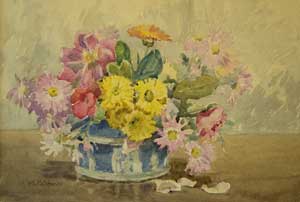Miss (Frances) Madge Kitchener
Miss (Frances) Madge Kitchener, 1 August 1889, Kasauli, India - 1974, Croydon, Surrey
- Born in Kasauli, India, daughter of Lieutenant-General Sir Frederick Walter Kitchener KCB (26 May 1858 - 6 March 1912) and Caroline Louisa (Fenton) Kitchener (1856 - 1901), who were married on 27 November 1884 at All Saints, Malab, Bombay, India
- Niece of Horatio Herbert Kitchener, 1st Earl Kitchener KG, KP, GCB, OM, GCSI, GCMG, GCIE, PC, the famous 'Lord Kitchener of Khartoum Wants You' First World war recruitment posters
- Nurse in the French Red Cross, 1914-1920
- Decorated with the award of Royal Red Cross (RRC)
- Artist who ran the 'Little Gallery' 80, The Street
- Studied at The Slade School of Fine Art as well as in Paris and America.
- Designer of the original dodecagonal threepence with a thrift plant on the reverse. Though this was modified by Percy Metcalfe before it was introduced in 1937
- Miss Kitchener's Royal Mint designs for a three-penny piece, 1936-7 in Leatherhead & District Local History Society Proceedings Vol 6, No 4 2000 (published Feb 2001) p78
- A Brief History of the Brass Threepence
- Coins of England and Great Britain - Three Pence
- THE ‘BRASS’ THREEPENCE (1937-1970)
- ... Originally intended for use in transport, as bus fare for example
... a reverse design modified by Percy Metcalfe after sketches originally submitted in June 1936 by Miss Frances Madge Kitchener,
niece of military hero Lord Kitchener.
Miss Kitchener's conception for the coin, introduced as a type in this pattern, was for a sideways-appearing trio of thrift, or thistle plant,
flowers atop curling tendrils.
The idea for the reverse motif surely had been borrowed from the 1928 Irish Free State coinages which introduced the use of 'native flora and fauna' for reverse designs in place of the traditional royal insignia,
and in subsequent commercial versions the coin proved popular, useful and durable.
Two models of this were prepared in 1936 but abandoned as overly ornate, in favor of a less realistic or more deco-styled image of the plant,
but showing fuller flowers, which was finally adopted for the brass coinage of George VI later in 1937.
Source: Heritage to Offer Rare British Threepence Piece!

One of her water-colours
